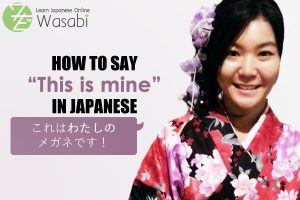How to speak like a woman/girl in Japanese
Welcome to the next video and article series with tutor Hidee! In this video and article we will explain how “女言葉(おんなことば)” or female gendered language works in Japanese. You can learn words and expressions used mostly by women.
| Table of Contents [Short Introduction] [Differences in Sentence Enders] [Differences in Asking Questions] [Differences in “I” and “You”] [Conclusion] |
[Short Introduction]
When you look for a Japanese teacher (and Wasabi is no different here, although we have one male tutor!), you will find that most Japanese teachers are women. It’s great, but women have a particular way of speaking Japanese. There are slight differences between the way that men and women talk in Japan.
It’s a good idea to learn the differences between feminine and masculine speech in Japanese so your Japanese sounds more fluent and natural.
[Differences in Sentence Enders]
One thing you’ll notice right off the bat about gendered language is that gendered language in Japanese isn’t all that difficult. It’s really only a few things you have to learn (for the most part), and once you’ve learned them, you’ll be okay.
Sentence enders are one of the two main ways that gendered language shows in Japanese. There will be some crossovers, which is okay but in general during casual speech you’ll want to use the right sentence ender so you can make a conscious decision about how you want to sound.
| Male sentence enders | Female sentence enders |
| 行く | 行くわ |
| 行くよ | 行くわよ |
| 行くね | 行くわね |
| 行くんだ | 行くの |
Example:
ずっと行きたかった日本に行くの!
I’m going to Japan where I’ve always wanted to go!
The above sentence would sound more female to a Japanese speaker. Now, you’ll notice that the masculine form tends (more often) to be a neutral form – that’s because originally sentence enders were all the same between both men and women. Besides these sentence enders, there’s also another type of sentence ender that deserves some focus, and that is “asking questions.” Let’s do that now.
[adsense]
[Differences in Asking Questions]
Asking questions in Japanese isn’t just adding a “か” to the end of a sentence and calling it a day, especially if you want to sound natural. It may be a good rule to stick to as a beginner, but eventually you will grow out of it and learn that there are other ways to ask questions. These other ways also happen to have both masculine and feminine forms in Japanese, so let’s see how you can distinguish between them.
| Male question patterns | Female question patterns |
| 行くか? | 行くの? |
| 行かないか? | 行かない? |
| 何だ? | 何なの? |
| どんな人なんだ? | どんな人なの? |
| いつ行くんだ? | いつ行くの? |
Example:
いつ日本に行くの?
When are you going to Japan?
This sentence would be perceived as rather feminine. However, things are changing rapidly in Japan and the “の” as a question ender is nowadays also used by men.
[Differences in “I” and “You”]
“I” and “You” are the last big differences between men and women in terms of how they speak. In fact, most likely, this is the only thing Japanese learners are taught about in regards gendered language, though usually just briefly.
| Female “I” | Female “You/He/She” |
| 私 (Most common, technically gender neutral but more commonly used by women these days) | あの方 (When referring to someone in the third person, formal) |
| あたし (A bit girly, used by girls and younger women) | あの子 (When referring to someone in the third person, usually another woman or child, casual) |
| わたくし (Very formal and a bit stiff/conservative, in formal cases also used by men) | あなた (Traditionally used, but usually replaced by the person’s name, sometimes casually used by wives to call their husbands) |
Example:
あの子はどんな子なの?
What kind of person is she/he?
When talking to someone, instead of saying “You”, refer to the person by their name. Example:
あゆみさんはどう思いますか?
What do you think, Ayumi?
In this case, you usually wouldn’t really say “あなた” but just use the name of the person you are talking to.
[Conclusion]
The purpose of feminine speech is to make female speech sound “softer” and more elegant. It might be hard to tell the difference when you’re just starting out, but after a while you should be able to know when something is “soft” or “hard” in Japanese. If you need to guess, choose the one that fits you best.
Additionally, please note that things change and some female gendered speech may sound a bit outdated these days. The best thing is to expose yourself to as much Japanese as possible to figure out in which cases it makes sense to use which type of speech.
That’s it for today. If you have any questions, you can always clear them up by booking a lesson with one of our native Japanese tutors. See you next time!
| 女言葉 | Female gendered language |
| の・なの | Female gendered question enders |
| 私 | Most classic and neutral form of “I”, slight female touch |
| あたし | I (for girls and young women) |
| わたくし | Most formal version of “I” |




